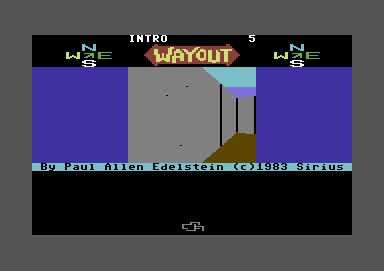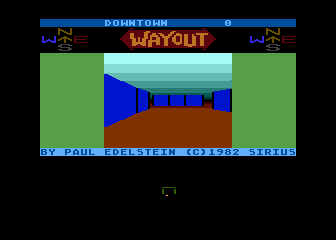Retro Replay Review
Gameplay
Wayout places you directly into the heart of a maze, rendered in an early first-person 3D perspective. Despite a relatively small gameplay window, the title delivers smooth 360-degree movement, letting you swivel and pivot as if you were really standing in the labyrinth’s corridors. The controls are intuitive: a few keystrokes or joystick taps rotate your viewpoint in exact 90-degree increments, and step-by-step movement keeps each corridor’s geometry crystal clear. This measured pace helps you focus on mapping and puzzle solving rather than twitch-based reflexes.
The core puzzle loop revolves around 26 uniquely designed mazes, each composed of right-angle turns and dead ends. As you navigate, Wayout automatically records your path using a built-in map-making kit. You also have a compass to ensure you maintain your orientation even when the walls look identical in every direction. Add to this the Cleptangle beast—a mischievous creature that can snatch away your map or compass—and you’ve got a dynamic obstacle that forces on-the-fly problem solving. Chase it down to reclaim your tools, then get back to work forging a route to the exit.
Scoring in Wayout is elegantly tied to your efficiency: the game measures how many movement units you use and logs your best performances to disk. You can slot up to nine in-progress games, letting you experiment with different strategies or tackle multiple mazes in parallel. Whether you aim for a perfect run in a single maze or marathon through all 26, the combination of accurate mapping, resource management, and the Cleptangle’s meddling keeps each session fresh and engaging.
Graphics
Given its vintage origins, Wayout’s graphics are deceptively simple yet functional. The small viewport displays crisp lines delineating walls and corridors, with a minimalistic aesthetic that emphasizes clarity over ornamentation. There’s no texture-clutter or flashy shaders—every visual element serves a singular purpose: to help you navigate the maze without distraction.
The game’s smooth rotation and step-based motion give a surprisingly immersive feel, despite the lack of modern graphical bells and whistles. When you spin your viewpoint, the world pivots around you seamlessly, maintaining the illusion of real-world physics. This level of polish was remarkable for its time and still feels sophisticated in a retro context.
Complementing the 3D pane is a 2D automap display that fills in behind-the-scenes geometry as you explore. Walls appear in real time, ensuring you never lose your position—and when the Cleptangle makes off with your mapping kit, the map freezes, heightening the tension. The simple color scheme and wireframe lines strike a perfect balance between readability and atmospheric immersion.
Story
Wayout doesn’t burden you with an elaborate narrative; instead, it offers a minimalist premise: you are trapped in a vast, twisting maze and must find the exit. This stripped-down storyline leaves room for player-driven drama, where each turn and dead end becomes a personal triumph or setback. The absence of cutscenes or dialogue allows you to project your own sense of discovery and dread onto the environment.
The Cleptangle beast adds a layer of emergent storytelling, acting both as a hindrance and an unpredictable companion. Its theft of your compass or map injects suspense into what could otherwise be a sterile puzzle exercise. Chasing the Cleptangle through branching corridors often yields comedic relief or nail-biting chase sequences—moments you’ll share with fellow players as you recount how many steps you took before finally cornering the creature.
Wind mechanics and fireflies further animate the maze world. At first glance, gusts of wind blocking certain passages may seem arbitrary, but as you learn to follow firefly patterns, a subtle environmental narrative emerges. These tiny creatures drift predictably in the wind’s direction, giving you vital clues about how to overcome each obstacle. In this way, Wayout weaves a story of resourcefulness and adaptability without a single line of text.
Overall Experience
Wayout remains a compelling journey for anyone intrigued by classic puzzle design and early 3D innovation. The combination of methodical exploration, dynamic obstacles, and precision scoring creates a deeply satisfying gameplay loop. Each maze feels like a fresh mental workout, and the ability to save multiple sessions encourages experimentation and long-term engagement.
The game’s minimalist graphics and story-free framework are strengths rather than liabilities. By stripping away nonessential elements, Wayout focuses squarely on the pleasure of discovery and the rush of solving each winding labyrinth. Whether you’re a retro gaming enthusiast or a newcomer curious about the genre’s roots, you’ll appreciate how well every mechanic serves the core experience.
Ultimately, Wayout offers a timeless invitation to test your spatial reasoning and perseverance. Its early 3D perspective holds historical interest, but more importantly, it remains a brilliantly designed puzzle adventure. If you enjoy mapping challenges, resource management, and the occasional impromptu chase, Wayout is well worth adding to your collection.
 Retro Replay Retro Replay gaming reviews, news, emulation, geek stuff and more!
Retro Replay Retro Replay gaming reviews, news, emulation, geek stuff and more!









Reviews
There are no reviews yet.